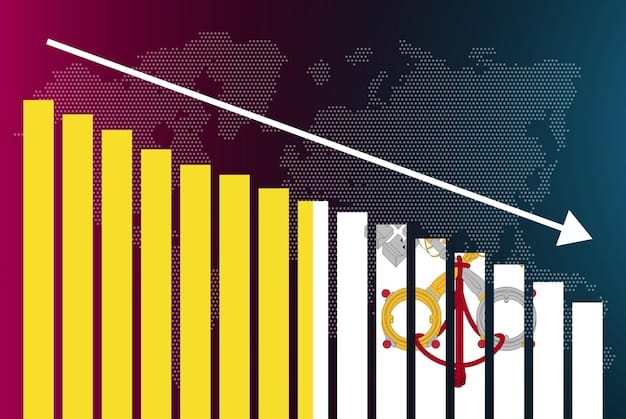Global Debt Surge: Impact on US Financial Stability

The projected increase in global debt levels poses significant risks to US financial stability by potentially triggering economic downturns, increasing market volatility, and undermining the strength of the US dollar, impacting investments and the overall economy.
The global economy is currently facing a concerning trend: a projected increase in global debt levels. This surge in debt raises critical questions about its potential impact on the financial stability of the United States. Understanding how will the projected increase in global debt levels affect US financial stability requires a comprehensive analysis of the interconnected global financial system and the specific vulnerabilities within the US economy.
Understanding the Global Debt Landscape
The accumulation of global debt is a multifaceted issue driven by various factors, including government spending, corporate borrowing, and consumer credit. Understanding the scale and composition of this debt is crucial for assessing its potential impact on the US.
Here’s a deeper look into the main drivers:
Government Debt
Many countries have increased their government debt to finance infrastructure projects, social programs, and economic stimulus measures. This borrowing is often undertaken to support economic growth and improve living standards, but it can also lead to fiscal challenges if not managed carefully.
Corporate Debt
Companies around the world have increasingly relied on debt to fund expansions, acquisitions, and operational activities. While borrowing can fuel growth, excessive debt can make firms vulnerable to economic downturns and higher interest rates.

Household Debt
Consumer debt, including mortgages, auto loans, and credit card balances, has also contributed to the growing global debt burden. High levels of household debt can constrain consumer spending and increase the risk of defaults during economic slowdowns.
Here are some key contributing factors to the rise in global debt:
- Low Interest Rates: Prolonged periods of low interest rates have made borrowing more attractive, encouraging governments, corporations, and individuals to take on more debt.
- Economic Stimulus: Governments have used borrowing to finance stimulus packages aimed at mitigating the impact of economic crises, such as the 2008 financial crisis and the COVID-19 pandemic.
- Demographic Changes: Aging populations and growing healthcare costs have put pressure on government finances, leading to increased borrowing.
The global debt landscape is shaped by various factors, from low interest rates to government stimulus efforts. Managing this debt requires careful fiscal policies and international cooperation to mitigate potential risks to financial stability.
Potential Risks to US Financial Stability
Increased global debt levels can pose several risks to US financial stability. These risks can manifest through various channels, including economic contagion, financial market volatility, and currency fluctuations.
Here are the critical vulnerabilities:
Economic Contagion
A major debt crisis in one country or region can quickly spread to others, including the US, through trade and financial linkages. This contagion effect can disrupt economic activity and destabilize financial markets.
Financial Market Volatility
High global debt levels can increase the sensitivity of financial markets to adverse economic news and policy changes. This can lead to sudden and sharp declines in asset prices, affecting investment portfolios and pension funds in the US.
Currency Fluctuations
Countries with high levels of debt may experience currency depreciations, which can impact the competitiveness of US exports and increase the cost of imports. This can affect the trade balance and overall economic growth in the US.

Certain sectors within the US are particularly vulnerable to the impact of global debt. These include:
- Banking Sector: US banks with significant international exposure can suffer losses if foreign borrowers default on their debts. This can reduce the availability of credit and dampen economic activity in the US.
- Export Sector: A slowdown in global economic growth due to debt-related crises can reduce demand for US exports, hurting companies and workers involved in exporting goods and services.
- Investment Sector: US investors with holdings in foreign debt or equities can experience losses if global debt problems trigger market corrections. This can impact retirement savings and investment portfolios.
The surge in global debt levels carries various risks for US financial stability, including economic contagion, market volatility, and currency fluctuations. These risks necessitate careful monitoring, proactive policy measures, and international cooperation to safeguard the US economy.
Impact on US Interest Rates and Inflation
Global debt levels can exert significant influence on US interest rates and inflation. These effects are transmitted through several mechanisms, including monetary policy responses and investor behavior.
Here’s how:
Monetary Policy
The Federal Reserve may adjust US interest rates in response to global debt-related events. For example, if a major debt crisis threatens global economic stability, the Fed may lower interest rates to stimulate economic activity and support financial markets in the US.
Investor Behavior
High global debt levels can influence investor sentiment and risk appetite. Investors may become more risk-averse and seek safe-haven assets like US Treasury bonds, driving down US interest rates.
Furthermore, global debt can affect inflation in the US through:
- Import Prices: Currency depreciations in debt-laden countries can increase the cost of imports into the US, contributing to higher inflation.
- Demand Shocks: A global economic slowdown triggered by debt problems can reduce demand for goods and services, potentially leading to deflationary pressures in the US.
Historical Parallels
Looking back, several historical episodes illustrate the interplay between global debt, US interest rates, and inflation:
The Latin American Debt Crisis of the 1980s
This crisis led to increased risk aversion among investors, driving capital flows into the US and putting downward pressure on US interest rates.
The Asian Financial Crisis of 1997-98
Similar to the Latin American crisis, the Asian crisis prompted a flight to safety, which lowered US interest rates and contributed to a period of low inflation.
Global debt levels can significantly influence US interest rates and inflation through monetary policy responses, investor behavior, and trade dynamics. Monitoring these interactions is essential for policymakers to manage domestic economic stability effectively.
US Policy Responses and Mitigation Strategies
To mitigate the potential impact of rising global debt levels on US financial stability, policymakers can employ a range of strategies. These include regulatory measures, fiscal policies, and international cooperation.
Here are some effective approaches:
Regulatory Measures
Strengthening the regulatory framework for US financial institutions can help reduce their exposure to global debt-related risks. This can include stricter capital requirements, enhanced risk management practices, and stress testing to assess the resilience of banks to adverse global scenarios.
Fiscal Policies
Prudent fiscal policies can help the US manage its own debt levels and reduce its vulnerability to global economic shocks. This can involve measures to control government spending, increase tax revenues, and promote sustainable economic growth.
Examples of effective policy responses include:
- Capital Controls: Implementing measures to restrict capital flows in and out of the US can help insulate the domestic financial system from global volatility. However, these controls must be carefully designed to avoid unintended consequences.
- Currency Interventions: The Federal Reserve can intervene in currency markets to stabilize the value of the US dollar during periods of excessive volatility. This can help mitigate the impact of currency fluctuations on trade and inflation.
- Bilateral and Multilateral Agreements: The US can work with other countries and international organizations to address global debt problems and promote financial stability. This can involve coordinating policy responses, providing financial assistance to struggling countries, and promoting reforms to the international financial system.
International Cooperation
Working with international organizations like the International Monetary Fund (IMF) and the World Bank can help address global debt problems and coordinate policy responses.
Mitigating the impact of rising global debt levels on US financial stability requires a multifaceted approach encompassing regulatory measures, fiscal policies, and international cooperation. By implementing these strategies, policymakers can enhance the resilience of the US economy to global economic shocks.
The Role of International Institutions
International institutions play a crucial role in managing global debt and fostering financial stability. Organizations like the International Monetary Fund (IMF) and the World Bank provide financial assistance, policy advice, and technical support to countries facing debt problems.
Here’s a detailed view:
IMF’s Role
The IMF monitors global economic developments, assesses the financial health of member countries, and provides loans to countries facing balance of payments crises. The IMF also promotes sound economic policies and provides technical assistance to help countries manage their debt.
World Bank’s Role
The World Bank focuses on promoting long-term economic development and poverty reduction in developing countries. It provides loans, grants, and technical assistance to help countries improve their infrastructure, education, and healthcare systems. The World Bank also plays a key role in debt relief initiatives for heavily indebted poor countries.
Examples of successful interventions by these institutions include:
- The Heavily Indebted Poor Countries (HIPC) Initiative: This initiative, launched by the IMF and the World Bank, provides debt relief to the world’s poorest and most indebted countries. The HIPC initiative has helped many countries reduce their debt burdens and allocate more resources to poverty reduction and economic development.
- The IMF’s Response to the Global Financial Crisis: The IMF provided substantial financial assistance to countries affected by the global financial crisis of 2008-09. This helped stabilize financial markets and prevent a deeper global recession.
Challenges and Limitations
Despite their important roles, international institutions face several challenges and limitations in managing global debt. These include:
These institutions are vital for managing global debt, but they face challenges in ensuring effective and equitable solutions. Addressing these issues is crucial for promoting sustainable global financial stability.
Future Trends and Uncertainties
Looking ahead, several trends and uncertainties could shape the future of global debt and its impact on US financial stability. These include technological advancements, geopolitical risks, and demographic changes.
Here are some factors to consider:
Technological Advancements
Technological innovations, such as artificial intelligence and blockchain, could transform the global financial system and alter the dynamics of debt. For example, AI could improve risk management and debt collection, while blockchain could enhance transparency and reduce transaction costs.
Geopolitical Risks
Geopolitical tensions, such as trade wars, political instability, and military conflicts, could disrupt global trade and financial flows, exacerbating debt problems. These risks can also lead to increased risk aversion among investors, driving capital flows into safe-haven assets like US Treasury bonds.
Some potential scenarios include:
- A Rise in Global Protectionism: Increased trade barriers and tariffs could reduce global trade and economic growth, making it more difficult for countries to service their debts.
- Increased Cyber Threats: Cyberattacks on financial institutions and critical infrastructure could disrupt financial markets and undermine confidence in the global financial system.
Demographic Changes
Aging populations and declining birth rates in many countries could put pressure on government finances, leading to increased borrowing. These demographic trends can also reduce economic growth and productivity, making it more difficult for countries to manage their debts.
Navigating these trends requires proactive policies and international cooperation. The US must adapt its strategies to address emerging challenges and capitalize on new opportunities to ensure long-term financial stability.
| Key Point | Brief Description |
|---|---|
| ⚠️ Global Debt Risks | Economic contagion, financial market volatility, and currency fluctuations. |
| 📉 Interest & Inflation | Global debt impacts US monetary policy and investor behavior, affecting rates and inflation. |
| 🛡️ Policy Responses | Regulatory measures, fiscal prudence, and international cooperation are vital. |
| 🌍 International Role | IMF and World Bank manage debt via aid, policy, and technical support. |
Frequently Asked Questions
▼
Global debt refers to the total amount of debt owed by governments, corporations, and individuals worldwide. It’s increasing due to low interest rates, economic stimulus measures, and demographic changes, making borrowing more attractive.
▼
US banks with international exposure face risks if foreign borrowers default. This can reduce credit availability and dampen US economic activity, impacting the stability of the financial system.
▼
The US can strengthen financial regulations, implement prudent fiscal policies, and cooperate internationally to address global debt issues. These measures aim to enhance the resilience of the US economy.
▼
The IMF monitors global economies, provides financial assistance, and offers policy advice to countries facing debt problems. They also help promote sound economic policies globally for managing debt.
▼
Technological advancements, geopolitical risks, and demographic changes could all shape the future, potentially exacerbating debt problems or creating new challenges for US financial stability and economic growth.
Conclusion
In conclusion, the projected surge in global debt levels presents considerable challenges to US financial stability. By understanding the risks, adopting proactive policies, and fostering international collaboration, the US can navigate these uncertainties and safeguard its economic future.





